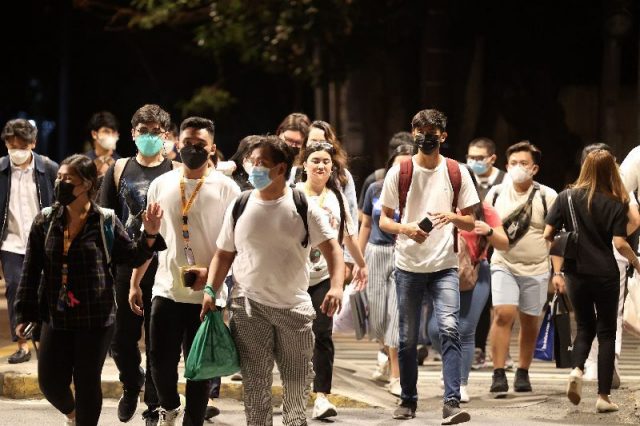
The public was once again reminded to be more vigilant in observing the minimum public health protocols after the government’s pandemic task force placed several areas under COVID-19 Alert Level 2.
Over the weekend, some news outlets reported that the Inter-Agency Task Force for the Management of Emerging Infectious Diseases (IATF-EID) “raised” the alert levels of 26 areas in a resolution signed on April 14.
The resolution, however, was only uploaded on the Official Gazette’s website, the government’s official journal, on April 22.
According to the IATF Resolution No. 6-C (series of 2023), the following areas are under COVID-19 Alert Level 2 from April 14 to 30.
- Benguet
- Ifugao
- Quezon Province
- Palawan
- Camarines Norte
- Masbate
- Antique
- Negros Occidental
- Bohol
- Cebu Province
- Negros Oriental
- Leyte
- Western Samar
- Lanao del Norte
- Davao de Oro
- Davao del Norte
- Davao del Sur
- Davao Occidental
- North Cotabato
- Sarangani
- Sultan Kudarat
- Dinagat Islands
- Basilan
- Maguindanao
- Sulu
- Tawi-Tawi
The rest of the areas not mentioned are still under COVID-19 Alert Level 1, the most lenient of the government’s pandemic alert levels.
The update alarmed some Filipinos, but the health department said that it was not a form of COVID-19 alert level escalation.
“These [provinces] have maintained their Alert Level 2 status since June 2022,” the health agency clarified on Sunday, April 23.
“No province or city has been escalated to Alert Level 2 from Alert Level 1 since January 2023,” it added.
Moreover, the Department of Health said that the COVID-19 alert level is not due to a higher number of cases.
“While these areas have reached low-risk classifications for cases and utilization rates, these have [COVID-19] vaccination rates lower than 70% of the target total and population,” it was quoted in another report.
The DOH said that admissions have increased in hospitals, but none reported experiencing full capacity.
The resolution said that the IATF had approved the recommendations of the Sub-Technical Working Group for Data Analytics, which placed the mentioned areas under Alert Level 2.
Under COVID-19 Alert Level 2, some establishments can only operate at a 50% indoor capacity for fully vaccinated individuals and those below 18 years of age, even if unvaccinated.
Meanwhile, the outdoor capacity is only 70%.
On the other hand, those under Alert Level 1 are allowed to operate at full capacity, provided that it is consistent with the public health protocols.
The minimum public health protocols include face masking, handwashing, physical distancing of at least one meter, and observing proper cough etiquette.
‘COVID-19 never went away’
The announcement of the COVID-19 alert levels prompted some Pinoys to remind their fellow citizens to be continuously vigilant of the viral disease despite it not causing as much furor to the public as before.
“#COVID19 never went away. This increase in cases is the result of state-led abandonment of public health measures and the absence of communal empathy. #CovidIsNotOver,” a Twitter user said in response to the reports.
“We were in the hospital tapos kasabayan namin sa ICU l, [Covid] cases,” another online user wrote, referring to the Intensive Care Unit, a special hospital ward dealing with seriously ill patients.
“Get [your] booster shot if [you] haven’t yet!! Meron pa rin po [Covid],” wrote a different Pinoy, referring to the COVID-19 booster shots. The DOH recently opened slots for the second booster to the general adult population.
Physician Tony Leachon, former special adviser to the National Task Force Against COVID-19, also advised the public to continuously wear face masks.
Masking is already voluntary in indoor and outdoor spaces, although the DOH advises it to be “mandatory” in both spaces, including in public transport, if physical distancing “is not possible.”
Masking remains one of the most effective ways to prevent COVID-19 transmission since it protects the wearer from respiratory droplets and virus-laden aerosols.
The virus can also be transmitted by asymptomatic people, or those who are infected but do not show any symptoms of the disease.
Last week, the DOH logged a 23% increase in new COVID-19 cases from April 10 to 16, compared to the average number from April 3 to 9.
The health agency has previously detected different Omicron subvariants that are more transmissible than the original Omicron variant — which is already the most infectious among the main COVID-19 variants.
READ: Filipinos told: COVID-19 still here after Omicron subvariant XBB.1.5 detection | Masks and boosters: Pinoys urged to be vigilant amid infectious Omicron subvariant BQ.1 | Still no DOH secretary as gov’t detects Omicron subvariant XBB and variant XBC
The country has over four million confirmed COVID-19 cases, including more than 66,000 deaths, since the pandemic began in early 2020.
There are a total of 4,657 confirmed COVID-19 cases as of April 21, according to the DOH’s yet-to-be-updated COVID-19 tracker.









